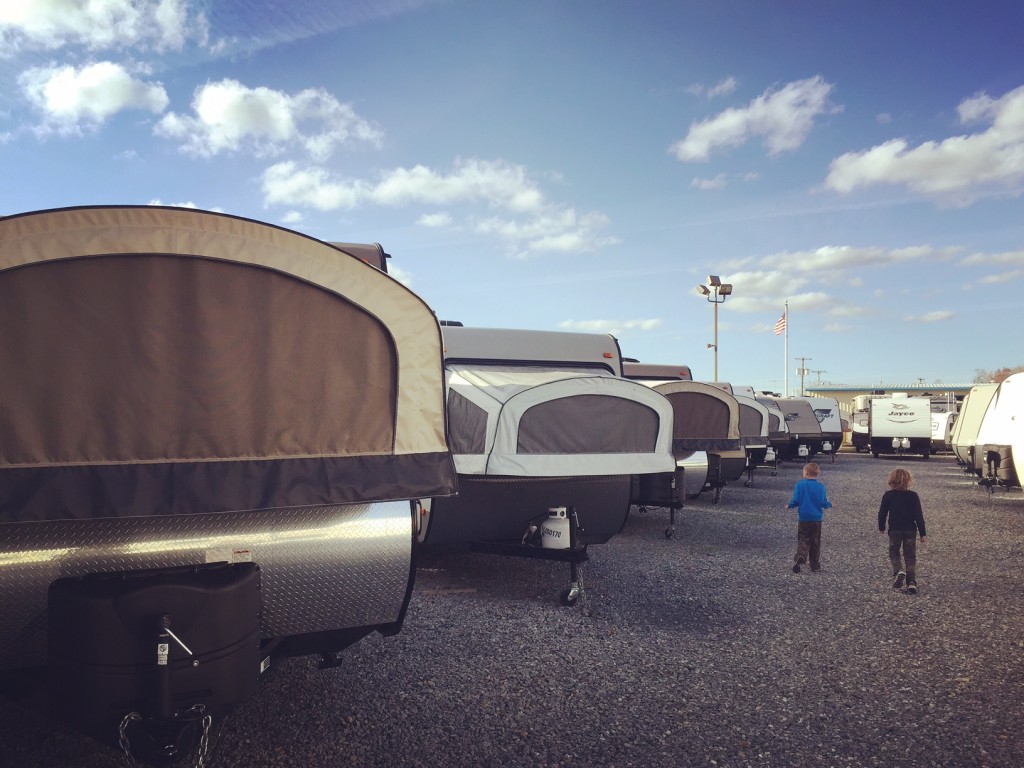
The Wall Street Journal recently published a feature about the state of the RV industry that was interesting, and very much worth reading, but somewhat flawed in its perspective.
RV Sales Revive, but Without Frills (WSJ, Dec. 23, 2015)
The article’s first sentence declares that “Americans are buying recreational vehicles at the fastest rate in more than a decade.” Then the author, James R. Hagerty, quickly pivots and writes that “Unfortunately for RV makers, many are hitting the road in smaller, less expensive models.” I find his use of the word “unfortunately” to be unfortunate.
For which RV makers is this unfortunate? After all, not every RV maker is building large, expensive, class A diesel pushers. Trust me on this, there are plenty of manufacturers who are mighty happy that Americans are buying “smaller, less expensive models.” One of the hottest companies in the industry right now is called Little Guy Worldwide. Hagerty is also only totally right about the “less expensive” part. If you’ve been to a campground lately you’ve probably seen plenty of towables over 30 feet–and yes–most of them are inexpensive when compared to motorhomes–but not much smaller.
Hagerty’s feature consistantly implies that the RV Industry’s breathtaking comeback is deeply flawed because its customers want light and cheap. I concede that the comeback has not been as great for those companies who focus on luxury and luxury only, but for the rest of the industry, life is good. They are not reluctantly making lighter and cheaper rigs, they are building them with complete intentionality. This is the comeback that they planned, not the flawed comeback that the Wall Street Journal sees.
During the recession the major RV manufacturers intentionally sought to build smaller and lighter units that could be towed by the family SUV or minivan. And guess what? Those units are selling like hotcakes. When the general public thinks about RV’s they often think about blinged out motorhomes. But 90 percent of RV’s sold are towable units, many of which cost less than $20,000.
So why else are Americans gravitating towards smaller and cheaper rigs? Because an increasing number of younger people are buying RV’s, and they are buying what they can afford–not what the Wall Street Journal wants them to be able to afford. Many younger buyers (think millennials) also want to keep things simple and keep their footprints smaller. More power to them.
I am POSITIVE that the RV industry is thrilled about the decreasing age of RV ownership. In fact, they are doing the happy dance. Have you seen a Go RVing commercial on television or social media? These ads are very deliberately courting younger buyers–and the RV industry knows that they are going to purchase smaller rigs. However, the article implies that many older buyers are also making the decision to go smaller and lighter. If this is the case, then most of the industry is certainly making up those lost margins with increased volume. The RV manufacturers are playing the long game–and they are winning.
But it seems to me like everyone is winning right now. Consumers have a wide variety of models to choose from and they are competitively priced. Manufacturers have more customers than they have had in a decade, and those customers are younger, and will probably make more total RV purchases in their lives than previous generations.
But who is the biggest winner in this new golden age of RVing? It might just be the campground industry. All of those shiny new RV’s are going to be heading to America’s campgrounds in record numbers next summer. Best make your reservations now.
What are your thoughts about this Wall Street Journal article on the RV Industry? I would love to hear from you in the comments section below.
Best-Jeremy






We bought a Thor Hurricane 31S a month ago, having had a Winnebago View for under a year. The View is way too small, even for 1 person let alone 2, in our opinion. No place to get dressed, really. The bathroom was too small and theres hardly any room in the living/bed areas. Shower so small its hard to wash your feet.
The Hurricane is very comfortable. NIce big shower. NIce little oven/stovetop. Dining area and a sofa. Separate bedroom. I know the diesel is supposed to be an advantage but it wasn’t always easy to find diesel fuel and whatever the fuel efficiency is, we’d never make up the price difference.
The Hurricane is about the same price as the View and its a lot more for the money.
I think the RV industry should focus on having something for everyone. That diversification makes it more likely that families will buy their first RV, and those cheaper, entry-level models are just the gateway drug to the bigger, pricier models. I think the RV industry needs to look at it as a lifetime lifestyle, with most families trading models as their family dynamics change.
Jeremy, great article! Yours, I mean. I didn’t read the one in the WSJ yet but I agree with your takeaway. It just shows how out of touch Wall Street is from the people.
Did the article even mention the fact that vehicles are required to have better fuel economy and that also affects the towing ability? Which, in turn, affects the type of RV that can be towed. When more are driving smaller cars, the smaller the RV.
As for motorized units, they are probably seeing the shift in generational thinking, wouldn’t you say?
We love our diesel truck. I don’t think we will ever go back to gas for towing or even in a class A. In reference to the previous post, we don’t have any problem finding fuel on the road. Of course in this day and age, the apps help there!!
We always focus on the diversification in the RV industry in our podcast, because we think that really is the main point: something for everyone from size to price point.
Karen S–as much as Jeremy and I know we would like to go smaller once the boys are not traveling with us, we could never fit comfortably in a Class B. For us, its not just about the storage, but about elbow room. Like you said, I want to change comfortably!
Julie–so true…people from the RV industry are ALWAYS referencing how vehicle developments affect RV design. They seem to be quite optimistic that tow vehicles will continue to be able to tow heavier rigs and get better gas mileage. TBD.
I think the WSJ writer’s expectations are somewhat skewed towards “selling more units of your most expensive products = revenue growth, lesser expensive products are just sabotaging the higher margin items.”
Meanwhile, the boomer generation is probably tapped out on purchases of $500K+ motorhomes. Those that can afford them already have them. So the industry absolutely has to start marketing to Gen X and even millennials.
Protip for any RV Industry folks reading this: Gen X’ers hate “Baby Boomer Brown.” If 99% of the rigs you produce have brown cabinetry and interior colors, you’re doing it wrong.
Oh dear, interior decor. We do see incremental change in some models geared toward a younger audience, but it definitely moves at a snail’s pace from the consumer viewpoint.
They are getting there on decor, check out some of the mentioned Little Guy’s product line, like their new truck camper, with very high end, European styling. Personally, though, I like the more American wood finishes, I just would prefer higher quality woods and not just plywood with contact paper over it to make it look like wood.
Excellent points Jerm! The Logan’s camping/RVing experience is only in its 3rd year. We’ve gone from a 9×9 tent, to 9×18 tent, to 1976 Ideal 24′ TT, to our 2016 Coleman 27’BH TT this past year. I have to give credit to Kerri Cox for my wife’s inspiration to want to get out there! I was a scout and hunter, so sleeping outdoors is no problem for me. My wife, Kodi, following @travelswithbirdy helped her realize all that is offered RVing. I believe that is what will help grow the buying markets. More people witnessing the joy we all get from “hooking & booking”. The manufacturers need to find that nitch of meeting the needs of the diversity of the next generations. My perfect RV, as of now, would be a light toyhauler 5th wheel under 32′. I have faith! But for now, we love our “Gary”.
I, for one, (well, the two of us) are happy to see the industry gravitate towards smaller and lighter units. Ever since we “caravaned” in Europe for a summer in an English caravan we have hoped that the U.S. manufacturers would emulate the European manufacturers. The way that they are able to cram lots of storage and sleeping into a tiny, light caravan is remarkable and admirable. One of my biggest objections to the North American R.V. industry has been their reliance on big, gas guzzling, tow vehicles. Our English caravan was towed by a 4 cyl. Ford sedan, our beloved Cortina. We went over the Alps through 9 countries with that little caravan behind us. In the 17′ unit there was a little bathroom (just toilet and sink, no shower) we had a couch that converted into bunk beds and the dinette converted into a bed for us. There was even a wardrobe with a drawer for each of us to store our clothes. So, I just hope that the smaller and lighter trend continues.
Excellent points! You are spot on. Why criticize an industry that is responding to its customers’ requests? We bought our first trailer after 20 years of tent camping. It is tiny, really TINY, but we love it! It has all of the comforts we wanted like a king sized memory foam mattress, stove, fridge, heater, hot water, on-board potty, and lots of storage. It’s light weight making it easily towable and fuel efficient for our small suv. 10 years ago when we first considered a trailer, those options were limited. We will trade up to a larger trailer at some point but absolutely love that the industry had something to offer us in the transition. We see so many options available right now and think that bodes well for the future of the RV industry both in the US and up here in Canada.